Frank Lloyd Wright was an American architect, interior designer, and writer who is considered one of the most influential architects of the 20th century. He was born on June 8, 1867, in Richland Center, Wisconsin, and passed away on April 9, 1959, in Phoenix, Arizona.
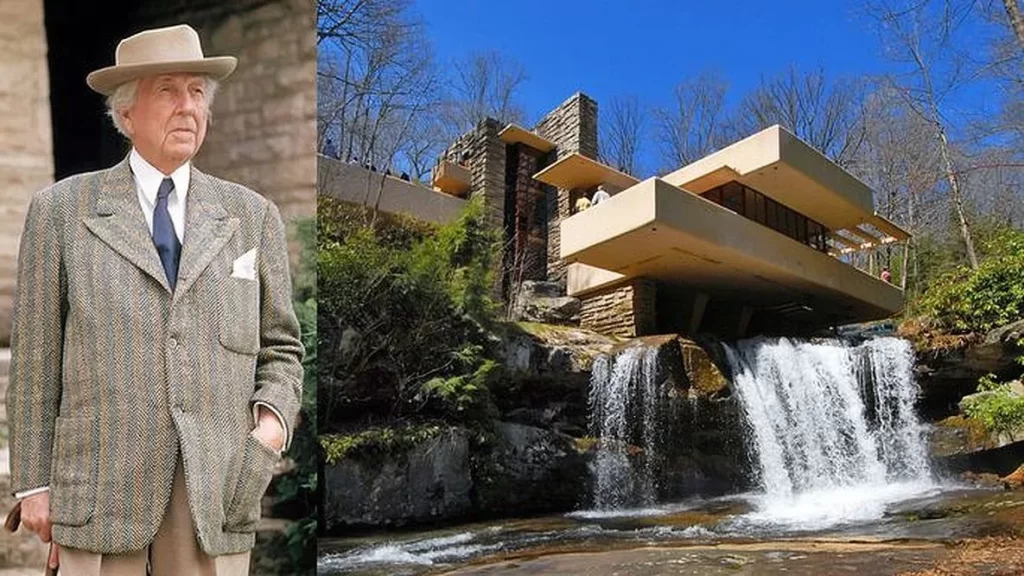
Wright’s contributions to architecture include his innovative approach to design, which emphasized the use of natural materials and the integration of buildings with their surrounding environment. He also developed the concept of “organic architecture,” which aimed to create buildings that were in harmony with the natural world.
Wright’s significance in American architecture is hard to overstate. He designed over 1,000 structures, including homes, public buildings, and museums, and his work helped shape the course of American architecture. Wright’s influence can be seen in the work of countless architects and designers who followed in his footsteps.

The impact of Wright’s work on the field of architecture is still felt today. His buildings continue to inspire awe and admiration, and his ideas about the importance of natural materials and organic design are still relevant. Wright’s contributions to architecture have helped shape our understanding of what it means to design and build in a way that is both beautiful and sustainable.
If you want to know about the staircase design or landscape garden or requirements for disabled persons in a building, please click the link.
1) Early Life and Career
Frank Lloyd Wright was born on June 8, 1867, in Richland Center, Wisconsin, to a Welsh mother and a preacher father. Wright’s upbringing was marked by frequent moves as his father traveled for work, but he spent much of his childhood in the Midwest.
Wright’s early education included a few years at the University of Wisconsin, where he studied engineering. He later moved to Chicago and began working as a draftsman for architectural firms. In 1889, he was hired by architect Louis Sullivan, who became a mentor to Wright and helped him develop his distinctive style.
- Wright’s early notable works include the Winslow House in River Forest, Illinois, which he designed in 1893. The house features many of the elements that would become hallmarks of Wright’s work, including strong horizontal lines, natural materials, and an emphasis on integrating the building with its surroundings.
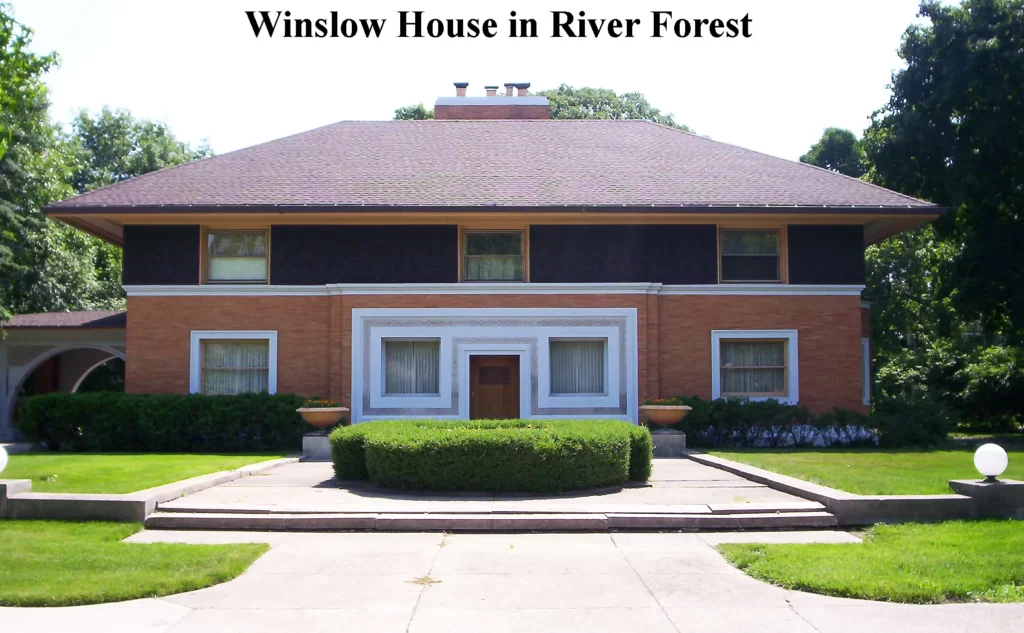
- In 1900, Wright designed the Unity Temple in Oak Park, Illinois, which is considered one of his most important early works. The temple features a unique design that emphasizes simplicity and light, with stained-glass windows and skylights that create a sense of warmth and openness.
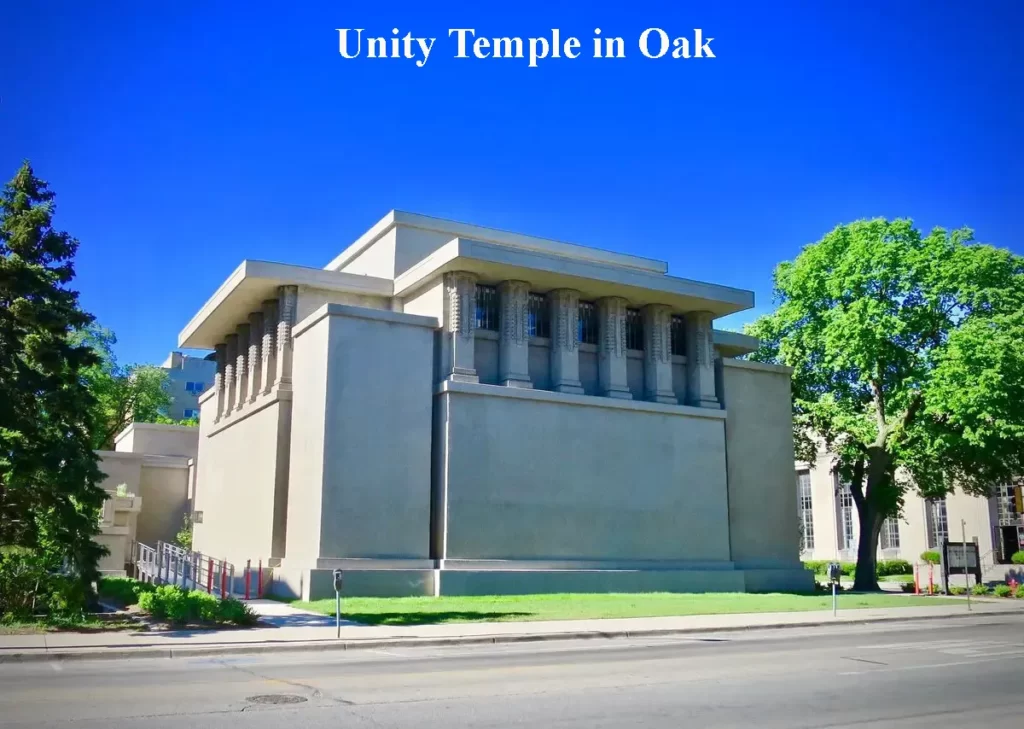
- Wright’s early work also included a number of residential designs, including the Prairie House style that he developed in the early 1900s. These homes were characterized by low-pitched roofs, wide overhanging eaves, and an emphasis on horizontal lines. Notable examples of this style include the Robie House in Chicago and the Martin House in Buffalo, New York.

Overall, Wright’s early life and education helped shape his unique approach to architecture, and his early works set the stage for the many innovative designs that would come later in his career.
2) Philosophy and Style
Frank Lloyd Wright’s philosophy and style of architecture were deeply rooted in his belief in the importance of creating spaces that were both functional and beautiful, and that were in harmony with the natural world. His concept of “organic architecture” reflected this philosophy, and has become one of his most enduring contributions to the field of architecture.
Organic architecture, according to Wright, was an approach to building design that sought to create spaces that were in harmony with the natural environment. This meant using natural materials such as wood, stone, and brick, and incorporating the surrounding landscape into the design of the building. Wright believed that a building should be an extension of its surroundings, rather than an imposition upon them.
One of the key features of Wright’s architectural style was his use of natural materials. He believed that these materials were not only more beautiful than synthetic materials, but also more sustainable and better for the environment. Wright also emphasized the importance of craftsmanship in his buildings, and often designed custom-made furniture and fixtures to complement the architecture.
Another important feature of Wright’s architecture was his use of open space. He believed that buildings should be designed to accommodate the needs of their occupants, and that this often meant creating large, open spaces that could be used for a variety of purposes. This approach to building design was particularly evident in his designs for public buildings such as museums and schools, where the emphasis was on creating spaces that were both functional and inviting.
Overall, Wright’s philosophy and style of architecture were characterized by a deep respect for the natural world and a belief that buildings should be designed to enhance, rather than dominate, their surroundings. His concept of organic architecture, with its emphasis on sustainability, natural materials, and integration with the environment, has had a profound impact on the field of architecture and continues to inspire architects and designers around the world.
3) Major Works of Frank Lloyd Wright
Frank Lloyd Wright is renowned for designing some of the most iconic and significant buildings in the world. Here are three of his most notable works:
i) Fallingwater

Fallingwater, located in Mill Run, Pennsylvania, is considered one of Wright’s masterpieces. Completed in 1939, it was built for Edgar Kaufmann Sr. and his family as a weekend home. The house is built over a waterfall, with the main living space cantilevered out over the water. The design incorporates natural materials such as stone and wood and is meant to blend seamlessly with the surrounding landscape. Fallingwater’s open-plan design, expansive windows, and natural materials represent Wright’s philosophy of organic architecture.
ii) The Guggenheim Museum

The Solomon R. Guggenheim Museum in New York City is another iconic Wright building. Completed in 1959, the museum features a distinctive spiral design that creates a sense of flow and movement. The interior of the museum is open and spacious, with a continuous ramp that winds around a central skylight. The building’s unusual design was controversial at the time but has since become a beloved landmark and a testament to Wright’s innovative approach to architecture.
iii) The Robie House
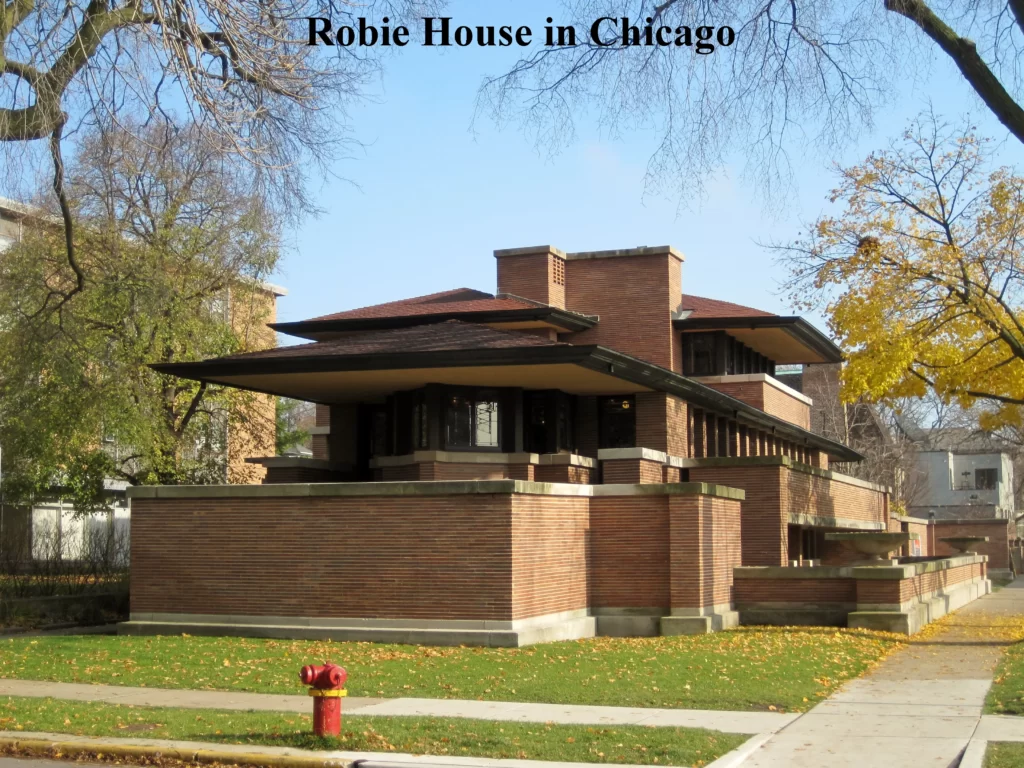
Located in Chicago, the Robie House is an example of Wright’s Prairie House style. Built in 1910, the house features a low-pitched roof, strong horizontal lines, and an emphasis on natural materials such as brick and wood. The design incorporates elements such as leaded glass windows, built-in furniture, and an open floor plan that creates a sense of unity and flow throughout the space.
These buildings are significant not only for their stunning design but also for their impact on the field of architecture. Wright’s work helped shift the focus of architecture from traditional, ornate designs to a more functional and organic approach. He emphasized the use of natural materials and integration with the environment, and his work continues to inspire architects and designers today.
Frank Lloyd Wright designed many other significant structures throughout his career. Here are a few more notable examples:
- Taliesin West – Located in Scottsdale, Arizona, Taliesin West served as Wright’s winter home and studio from 1937 until his death in 1959. The building is an example of Wright’s organic architecture, with a design that incorporates natural materials and blends seamlessly with the surrounding desert landscape.

- Hollyhock House – Designed for oil heiress Aline Barnsdall, the Hollyhock House in Los Angeles is a striking example of Wright’s Mayan Revival style. Completed in 1921, the house features decorative elements such as ornate carvings and bas-relief panels inspired by ancient Mayan art.
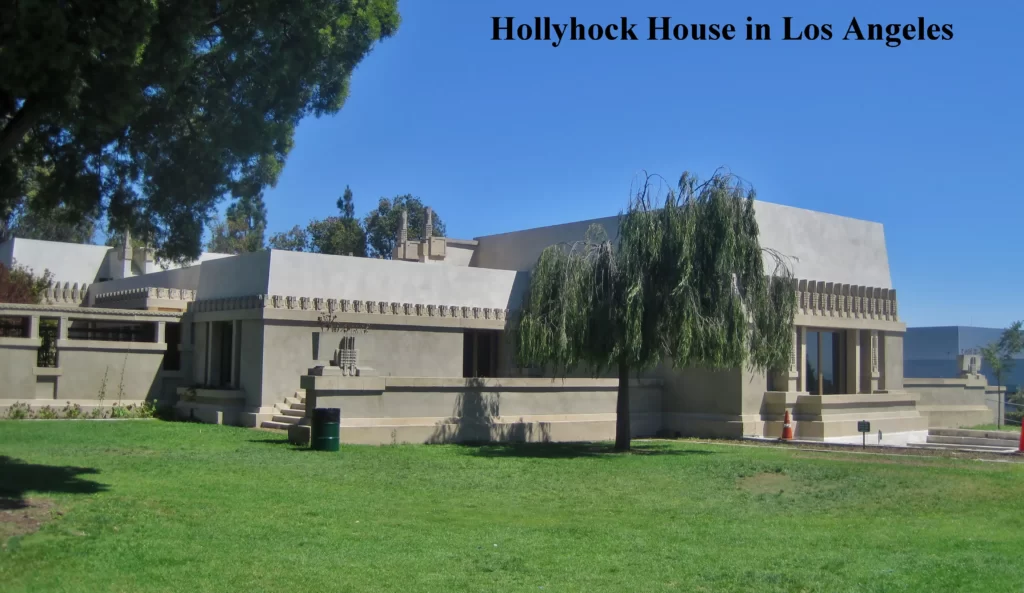
- Johnson Wax Headquarters – The Johnson Wax Headquarters in Racine, Wisconsin, was designed by Wright in 1936. The building features a distinctive “lily pad” design, with columns that resemble the plant’s leaves. The interior of the building features Wright’s signature use of natural materials and open space, with an innovative lighting system that illuminates the space from the ceiling.

Wright’s work continues to have a profound impact on the field of architecture. His focus on organic design and integration with the environment, as well as his use of natural materials and open space, helped pave the way for modern architecture. His buildings continue to inspire architects and designers around the world, and his legacy as one of the most innovative and influential architects of the 20th century remains secure.
4) Legacy and Influence
Frank Lloyd Wright’s lasting legacy and influence on architecture and design are significant and far-reaching. His innovative approach to building design and his emphasis on sustainability, natural materials, and integration with the environment have had a profound impact on the field of architecture and continue to inspire architects and designers around the world.
Many architects and designers have been inspired by Wright’s work, including Le Corbusier, Mies van der Rohe, and Alvar Aalto. Wright’s influence can be seen in their work, as well as in the work of contemporary architects such as Zaha Hadid, Bjarke Ingels, and Renzo Piano.
The impact of Wright’s ideas and principles on contemporary architecture and design is also significant. His emphasis on sustainability and the use of natural materials has become increasingly relevant in the face of growing concerns about climate change and the need for more sustainable building practices. Architects and designers today are increasingly focused on creating buildings that are environmentally responsible and energy-efficient, and Wright’s ideas continue to provide a valuable framework for this work.
Moreover, Wright’s emphasis on creating spaces that are both functional and beautiful has also had a lasting impact on the field of design. His work in furniture and interior design, as well as his holistic approach to building design, have influenced designers in a range of fields, from fashion to industrial design.
Overall, Frank Lloyd Wright’s legacy and influence on architecture and design are immense. His innovative ideas and principles continue to inspire architects and designers around the world, and his work remains a testament to the power of design to create spaces that are both beautiful and functional.
Frank Lloyd Wright’s influence on architecture in India goes beyond just his own work. He also had a significant impact on the development of modern architecture in the country. Here are a few more points to add:
- Influence on Le Corbusier: The Swiss-French architect Le Corbusier, who is famous for his work in Chandigarh, was heavily influenced by Frank Lloyd Wright. Le Corbusier visited Wright’s studio in the US in 1935, and the two architects corresponded frequently. Le Corbusier’s work in India, which includes the Capitol Complex in Chandigarh and the Mill Owner’s Association Building in Ahmedabad, shows Wright’s influence in its use of natural materials, open space, and integration with the surrounding landscape.
- Influence on Indian architects: Frank Lloyd Wright’s work and ideas have also influenced many Indian architects. One example is Balkrishna Doshi, who worked with Le Corbusier in the 1950s and later went on to establish his own practice. Doshi’s work, which includes buildings such as the Indian Institute of Management in Bangalore and the Aranya Low Cost Housing in Indore, shows the influence of Wright’s organic architecture and his focus on creating spaces that are both functional and beautiful.
- Legacy in India: Frank Lloyd Wright’s legacy continues to be felt in India today, with many architects and designers taking inspiration from his work. His emphasis on natural materials, open space, and integration with the environment is particularly relevant in a country like India, where the climate and geography have a significant impact on building design.
Overall, Frank Lloyd Wright’s influence on architecture in India is significant and enduring. His ideas continue to shape the way architects and designers approach building design, and his legacy as one of the most innovative and influential architects of the 20th century is secure.
5) Conclusion
In conclusion, Frank Lloyd Wright was a visionary architect whose innovative approach to building design and philosophy of organic architecture continue to inspire architects and designers around the world. His lasting legacy can be seen in some of his most significant works, such as Fallingwater, the Guggenheim Museum, and the Robie House, as well as in the work of countless architects and designers who have been inspired by his ideas and principles.
Wright’s emphasis on sustainability, natural materials, and integration with the environment has become increasingly relevant in the face of growing concerns about climate change and the need for more sustainable building practices. His focus on creating spaces that are both functional and beautiful has also had a profound impact on the field of design.
Overall, Frank Lloyd Wright’s contributions to the field of architecture and design cannot be overstated. His work remains a testament to the power of design to create spaces that are both beautiful and functional, and his legacy will continue to inspire architects and designers for generations to come.